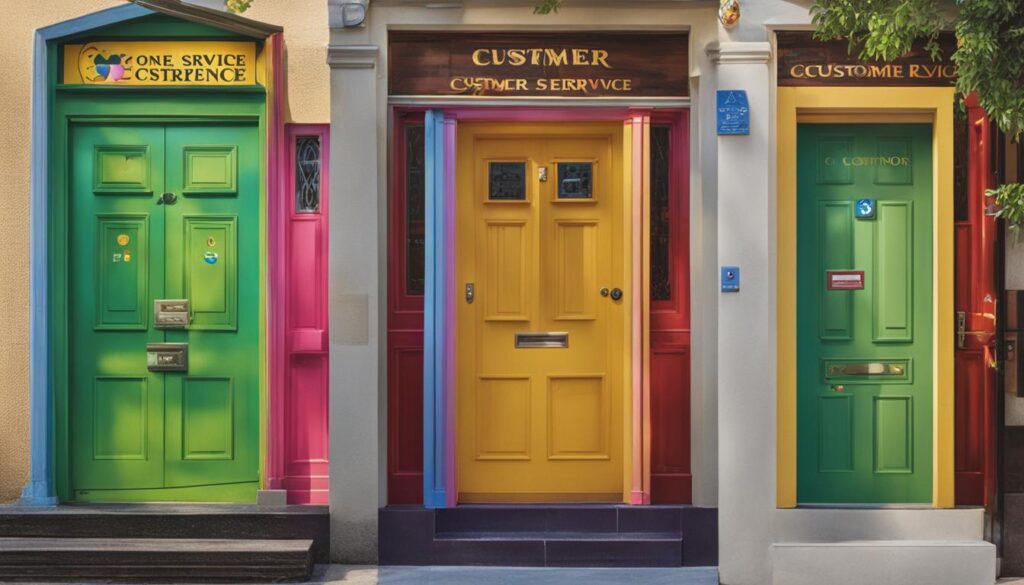Did you know that 86% of customers are willing to pay more for a better customer experience? And that companies investing in customer experience can expect a 70% increase in revenue within 3 years? These statistics highlight the importance of prioritizing customer experience in your customer service efforts.
But what exactly is customer experience, and how does it differ from customer service? Many people use these terms interchangeably, but they have distinct meanings and implications for your business. Understanding the difference is crucial to delivering exceptional service and enhancing customer satisfaction.
In this article, we will delve into the nuances of customer experience and customer service. We will explore how you can create a great customer experience strategy and deliver outstanding customer service that exceeds expectations. Are you ready to transform your customer service into a customer-centric approach that leaves a lasting impression?
Understanding the Difference Between Customer Service and Customer Experience
When it comes to providing exceptional service to your customers, it’s important to understand the distinction between customer service and customer experience. While these terms are often used interchangeably, they have different meanings and play different roles in shaping your customers’ perception of your brand.
Customer Service:
Customer service refers to the interactions and support provided to customers when they have a problem or inquiry. It is a reactive approach that focuses on resolving specific issues that customers may encounter.
Some key aspects of effective customer service include:
- Providing timely assistance and support
- Being knowledgeable about your products or services
- Having a pleasant and helpful attitude
- Resolving issues efficiently and effectively
Customer Experience:
Customer experience, on the other hand, goes beyond individual interactions. It encompasses the entire journey a customer has with your brand, from the moment they first discover your products or services to the post-purchase experience and beyond.
Customer experience is a proactive approach that focuses on creating a positive overall feeling and impression. It involves understanding your customers’ needs, preferences, and expectations, and consistently delivering on those to provide a seamless and remarkable experience.
Key factors that contribute to a great customer experience include:
- Developing a customer-centric approach to business
- Personalizing interactions and tailored solutions
- Proactively anticipating and solving problems
- Building strong emotional connections with customers
To measure the success of your customer service and customer experience efforts, it is important to utilize relevant metrics. Customer service is typically evaluated using customer satisfaction (CSAT) scores, which gauge the satisfaction level after each interaction. On the other hand, customer experience is commonly assessed using Net Promoter Scores (NPS), which measure the likelihood of customers recommending your brand to others.
“Customer service and customer experience are complementary elements in creating a positive relationship with your customers. While customer service focuses on resolving immediate needs, customer experience goes beyond that to create a lasting impression.”
It is important to note that both customer service and customer experience are vital for business success. While customer service is often the responsibility of a specific department, customer experience is the responsibility of the entire company. By prioritizing both aspects and aligning them with your business goals, you can create a strong foundation for cultivating loyal customers and driving growth.

| Customer Service | Customer Experience |
|---|---|
| Reactive approach | Proactive approach |
| Focuses on specific events | Focuses on creating an overall feeling |
| Measured using customer satisfaction (CSAT) scores | Measured using Net Promoter Scores (NPS) |
| Responsibility of a specific department | Responsibility of the entire company |
9 Ways to Create a Great Customer Experience Strategy
To create a great customer experience strategy, it’s important for businesses to prioritize customer satisfaction, reduce churn, and increase revenues. By implementing personalized services and proactive problem-solving techniques, you can enhance the overall customer experience. Here are nine effective ways to create a customer experience strategy that will leave a lasting impression on your customers:
- Develop a clear customer-focused vision: Align your organization’s goals with the needs and expectations of your customers. Create a vision that puts the customer at the center of every decision.
- Segment your customers: Identify different customer segments and create detailed personas to better understand their unique needs and preferences. This will allow you to tailor your services and interactions accordingly.
- Build emotional connections: Cultivate meaningful relationships with your customers by understanding their emotions and connecting with them on a deeper level. This will result in increased loyalty and customer satisfaction.
- Provide quick responses and solutions: Customers appreciate prompt and efficient service. Respond to their queries and resolve their issues in a timely manner to show that their satisfaction is your top priority.
- Prioritize quality service: Strive for excellence in every customer interaction. Train your staff to deliver exceptional service, ensuring that every touchpoint reflects your commitment to providing a superior customer experience.
- Actively listen to customer feedback: Encourage customers to share their opinions, suggestions, and concerns. Actively listen to their feedback and use it as an opportunity to make necessary improvements and enhancements.
- Ensure personalized service: Treat each customer as an individual by personalizing their experiences. Tailor your communications, offers, and recommendations to align with their preferences and previous interactions.
- Proactively solve problems: Anticipate potential issues and take proactive measures to address them before they become problems. Strive to exceed customer expectations by going above and beyond to resolve any issues they may encounter.
- Continuously improve: Embrace a culture of continuous improvement by regularly evaluating and refining your customer experience strategy. Stay up to date with industry trends and technologies to ensure you’re always delivering the best possible experience.
By implementing these strategies, you can create a customer experience that differentiates your business from the competition, builds customer loyalty, and drives long-term success.

Customer Satisfaction and Revenue Growth
By prioritizing customer experience and satisfaction, businesses can reduce customer churn and increase revenues. According to a study by Deloitte, companies that prioritize customer experience are 60% more profitable than those that don’t. Providing personalized, proactive, and high-quality service leads to higher customer satisfaction rates, which in turn drives customer loyalty and boosts revenue.
| Benefits of a Great Customer Experience Strategy | Impact on Business |
|---|---|
| Increased customer satisfaction | Higher customer retention and loyalty |
| Reduced customer churn | Lower acquisition costs |
| Improved brand reputation | Attracting new customers through positive word-of-mouth |
| Higher customer lifetime value | Increased revenues and profitability |
10 Ways to Deliver Great Customer Service
Providing exceptional customer service is crucial for creating a positive customer experience. Valuing your customers’ time and delivering service of high quality should be your top priority. By maintaining a pleasant attitude and being knowledgeable about your product or service, you can establish trust and build strong relationships with your customers. Emphasize creative problem-solving to address their needs effectively and ensure their satisfaction.
- Respond quickly to customer queries: Promptly addressing customer concerns shows that you value their time and are committed to providing excellent service. Aim for a quick response time to enhance their experience.
- Provide personalized service: Tailoring your service to meet individual customer needs showcases your attentiveness and dedication. Personalization is key to creating a memorable customer experience.
- Focus on the customer: Your customers should always be at the center of your interactions. Take the time to understand their preferences, anticipations, and pain points in order to offer relevant solutions and exceed their expectations.
- Actively listen: Paying attention to your customers’ feedback and concerns demonstrates your willingness to understand their needs. Actively listen to their opinions, suggestions, and complaints to continuously improve your service.
- Keep promises: Building trust is vital in customer service. Always follow through on your commitments and deliver on promises made. This fosters confidence and loyalty in your customers.
- Build a connection: Forge a meaningful connection with your customers by engaging in genuine conversations. Show empathy, understanding, and a willingness to assist. A personal connection enhances the overall customer service experience.
- Utilize knowledgeable resources: Equip your customer service team with the necessary skills and knowledge to provide accurate and helpful information. Well-trained and competent resources contribute to a smooth and efficient customer service experience.
- Be proactive in problem-solving: Anticipate potential issues and address them proactively. By taking a proactive approach to problem-solving, you can prevent escalations and ensure a seamless customer experience.
- Maintain a pleasant attitude: A positive and friendly demeanor can make a significant difference in customer interactions. Displaying empathy, patience, and respect helps create a pleasant and memorable customer service experience.
- Always take feedback seriously: Customer feedback is invaluable for improving your service. Actively seek feedback, consider it seriously, and use it to make necessary improvements. This demonstrates your commitment to continuously enhancing the customer service experience.
By implementing these strategies, you can deliver great customer service that leaves a lasting impression. Remember, customer service is not only about resolving issues but also about creating a positive and memorable experience at every touchpoint.

Conclusion
Creating the best customer experience in customer service is essential for business growth. By prioritizing customer experience and investing in strategies to enhance it, businesses can drive customer satisfaction, reduce churn, and ultimately achieve higher revenues.
Exceptional customer service is a crucial component of creating a positive customer experience. By following the best practices outlined in this article, such as valuing customers’ time, maintaining a pleasant attitude, and providing knowledgeable resources, businesses can build strong relationships with their customers and stand out from their competitors.
Remember, the key to success lies in proactive problem-solving, personalized service, and quick response times. Investing in a customer-centric approach, listening actively to customer feedback, and continuously improving based on their insights will further enhance the customer experience.
So, whether you’re a small business or a large corporation, make customer experience a top priority. By delivering exceptional customer service and fostering a positive customer experience, you can drive business growth and stay ahead in today’s competitive market.
FAQ
What is the difference between customer service and customer experience?
Customer service refers to the interactions that occur when a problem arises, while customer experience encompasses the entire customer journey. Customer service is reactive, while customer experience is proactive. Customer service is measured using customer satisfaction (CSAT) scores, while customer experience is measured using Net Promoter Scores (NPS). Customer service focuses on specific events, while customer experience focuses on creating an overall feeling. Customer service is the responsibility of a department, while customer experience is the responsibility of the entire company.
How can businesses create a great customer experience strategy?
To create a great customer experience, businesses should have a clear customer-focused vision and guiding principles. They should segment customers and create personas to better understand their needs and preferences. Building emotional connections with customers is important, as is providing quick responses and solutions. Businesses should prioritize quality service and actively listen to customer feedback. Taking customer feedback seriously and making necessary improvements is crucial for enhancing the customer experience.
How can businesses deliver great customer service?
Great customer service involves valuing customers’ time, having a positive attitude, being knowledgeable about the product or service, and creatively problem-solving. Responding quickly to customer queries and providing personalized service are also important. Focusing on the customer, actively listening, and keeping promises help create a positive customer service experience. Building a connection with customers and always taking their feedback seriously contribute to delivering great customer service.
